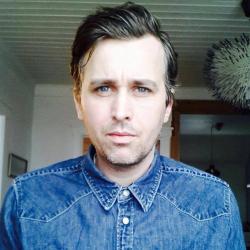“We are old friends, me, Óskar Jónsson and Hrafnkell Sigurðsson. We came out of the Icelandic punk scene,” says Stefán Jónsson, one of Iceland’s notable theatre directors. These old friends have now published an interesting book, an extension of an ongoing art exhibition called Arctic Creatures. The project is the result of them hiking around the wilderness of Iceland, artfully repurposing the trash they found on beaches around the country.
Great artists hiking
The old friends have come a long way from their youthful years. Stefán is a well-known actor and one of Iceland’s most skilful directors that can switch easily between cutting-edge avant-garde and traditional theatre. Óskar Jónsson has Icelandic cult classic films like Sódóma Reykjavík under his belt and Hrafnkell Sigurðsson is a frequent guest in The Reykjavík Grapevine’s art section, in addition to being among the best-known visual artists in Iceland for years.
The three have been friends, drifted apart and reconnected again through various projects over the course of their lives to date — Stefán, for example, has acted in Óskar’s films and Hrafnkell and Óskar have had various collaborations throughout the years.

Trash in the wilderness
“And of course, as we get older, we don’t go as often to the bar, so we started to seek out nature,” Stefán explains. They started to hike Hornstrandir, one of the most isolated places in Iceland. They have been hiking together for 12 years now, venturing into the wilderness with nothing but the belongings on their backs and their shared companionship.
“We have to weigh everything, from food to whatever, and then we sleep in tents in whatever weather Iceland throws at us,” he says.
It was during their hikes that the trio started noticing that the beaches of Iceland, no matter how isolated, were littered with junk. Mostly trash from Iceland’s sizeable fishing fleet—everything from nets to plastic barrels and lifebuoys.
Being three highly creative individuals, they started joking around, taking inventive pictures of themselves with this trash, sometimes reenacting historical scenes and sometimes just creating absurd moments. They published the photos on social media and got a lot of strong reactions. So they kept on doing it, while realising that perhaps there was a bigger story here.

Plastic can the new cairn?
“The original idea was not to create art, but slowly we got there. There is a lot of pollution on Icelandic beaches, and although we are raising awareness of this, this is not really some kind of a declaration on our behalf,” he explains. “In some ways, we are recycling the pollution in an artistic way.“
The rule they used was simple. They could only reuse the trash on the beaches to create the art and it is incredible to see how complex the props/trash can be.
“We found, for example, an old plastic barrel that reminded us of a cairn in ancient Rome. And we recreated a Roman scenario with a buffet and then we dressed in the nets, which looked like togas. In some ways, it’s an obvious reference to the overconsumption,” Stefán says. He adds that it’s an odd idea also, that hundreds, even thousands, of years from now, these same barrels will be on display like the ancient cairns in museums today.
The Trash throne
The three friends talked to the publishing house Bjartur and presented the idea of publishing a book with the photos and thoughts about these trips. Bjartur jumped at the opportunity. The book is out now, clocking in at 100 pages and written in English.
Stefán explains that the book is more or less just photos, with titles of the creations and the locations of where each was shot. And on top of this, they have an exhibition at the Pop Up Gallery at Hafnartorg which is nothing less than a grim reminder of the trash on the beaches of Iceland. The artists have picked up hundreds of plastic bottles during their walks and have crafted a throne out of the discarded plastic Although Stefán, Óskar and Hrafnkell are perhaps not trying to make a political statement, one can not shy away from the disaster of pollution and global warming when observing their photo book and installation.
Buy subscriptions, t-shirts and more from our shop right here!
















